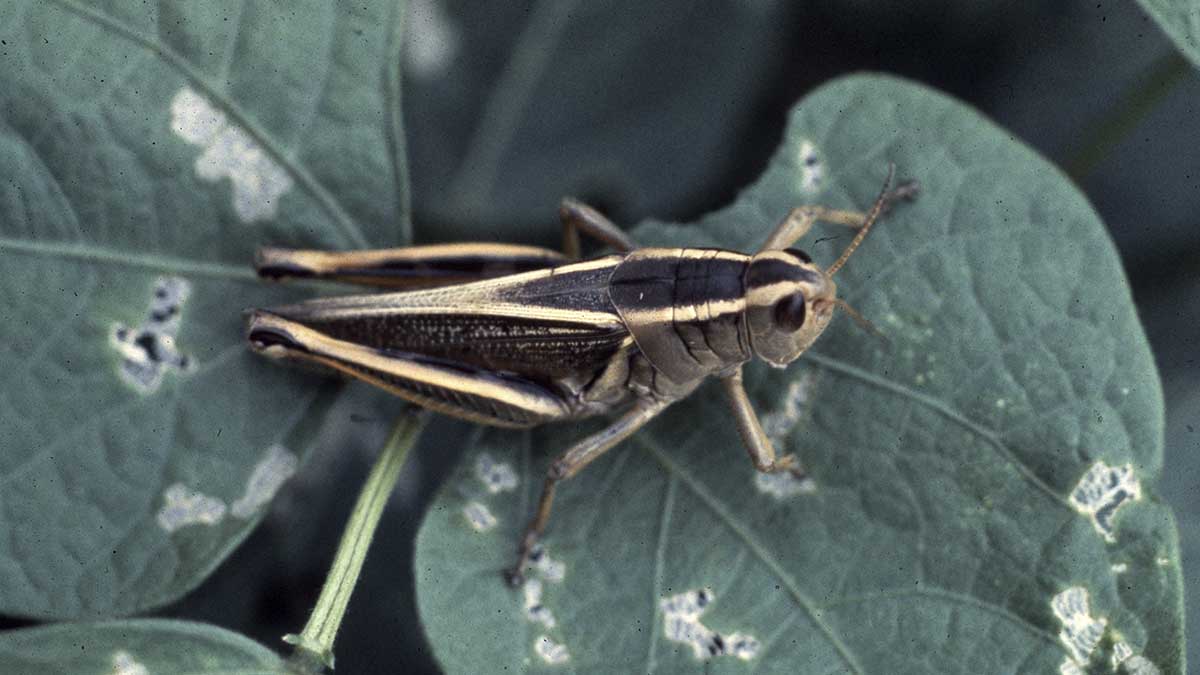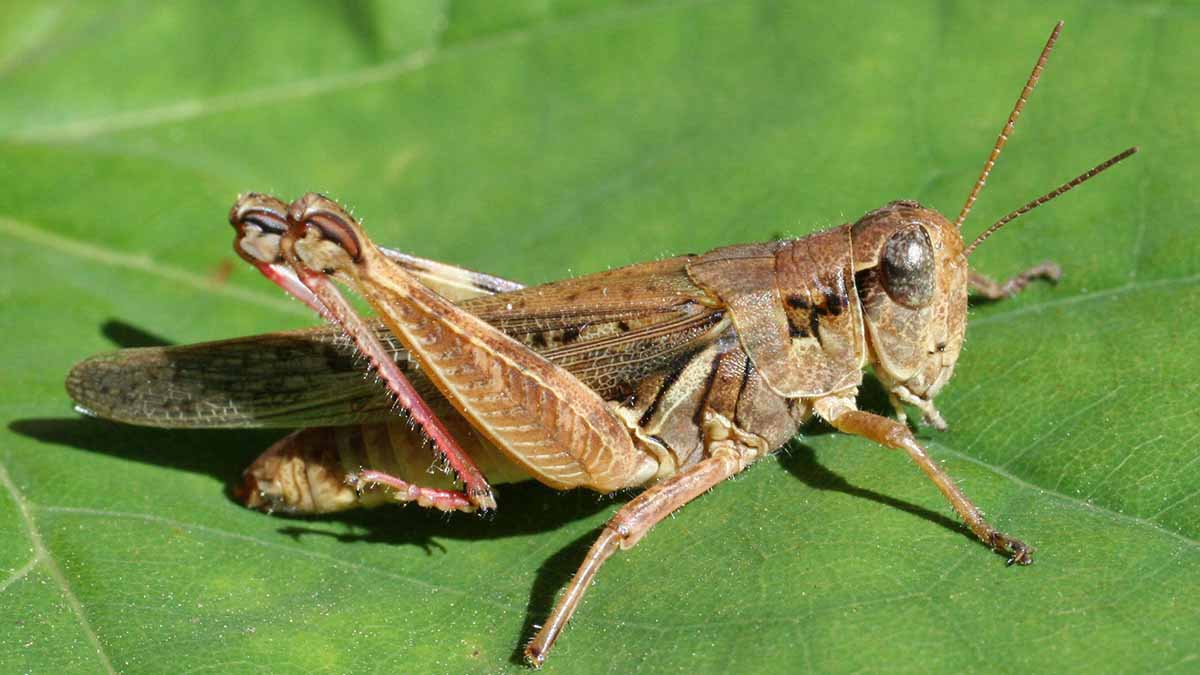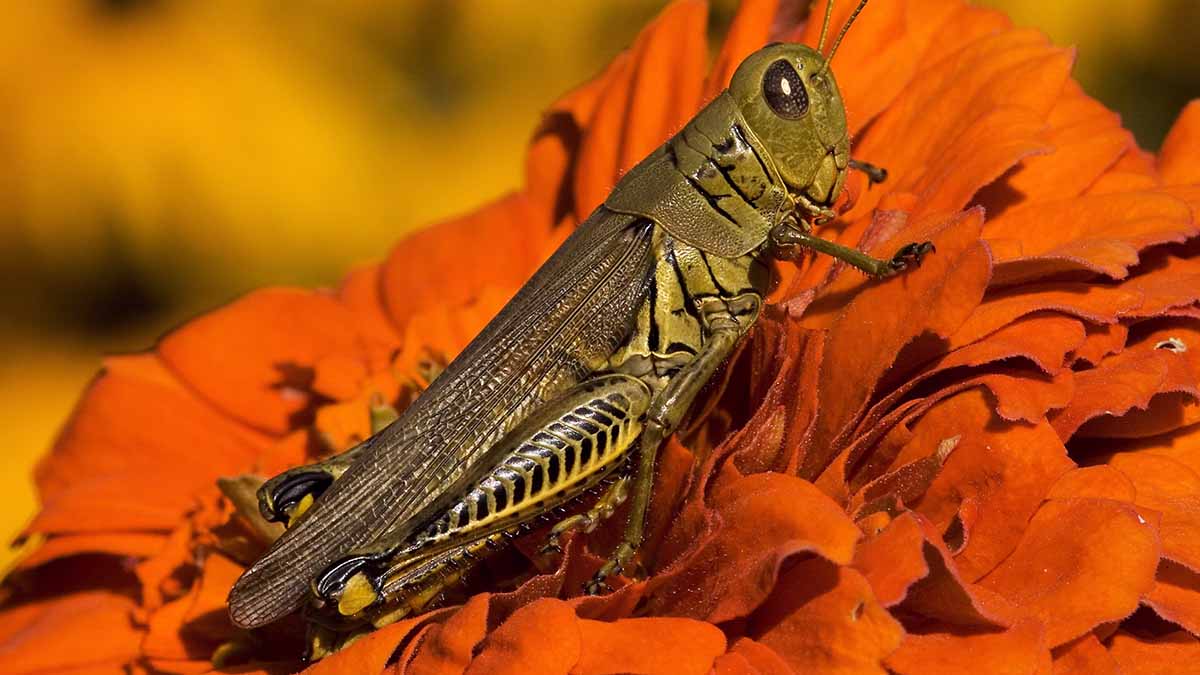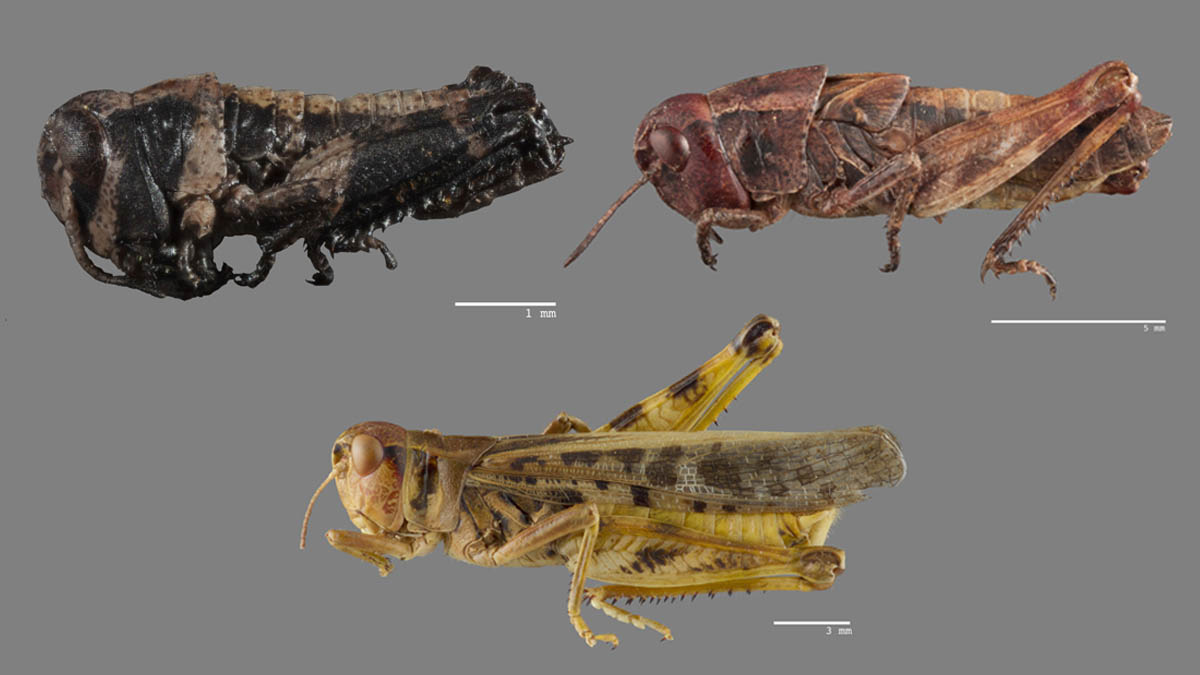Grasshoppers
Pest Common Name
- Twostriped Grasshopper (Melanoplus bivittatus)
- Migratory Grasshopper (Melanoplus sanguinipes)
- Red-legged Grasshopper (Melanoplus femurrubrum)
- Differential Grasshopper (Melanoplus differentialis)
- Clearwinged Grasshopper (Camnula pellucida)
- Many others
- Extreme generalists, causing defoliation and seed/fruit loss in many plants
- Important crops: sugar beet, cereals, legumes (green and dry), canola and other oilseeds, pasture and grass hay, alfalfa and clover (hay and seed), corn, mint
- Most vegetables and fruits
There are three major groups of grasshoppers present in Idaho: the slant-faced grasshoppers, the band-winged grasshoppers and the spur-throated grasshoppers.
The slant-faced grasshoppers have angled faces and narrow bodies. These grasshoppers are also common but not often injurious to crops and gardens.
The bandedwing grasshoppers have bright colored wings and make snapping noises when they fly. These grasshoppers are also common but not often injurious to crops and gardens.
The spur-throated grasshoppers get their name from the tubercle projecting between their front legs. This group includes most of the injurious species in Idaho.
Adults of most of the most injurious species range in length from 3/4-1 3/4 inch (20-45 mm). They generally have a robust body, and long legs with enlarged femurs. Antennae are short and slender.
Nymphs are somewhat similar in appearance to adults, though with a head that is relatively larger as compared with the body and often different coloring (Figure 5). Nymphs are difficult to identify. Figures 1-4.





Biology
Many of the grasshoppers of concern in crops and home gardens hatch in late spring after overwintering as eggs in pods. Eggs are often laid all in the same area with favorable soil conditions, areas known as “egg beds.” There are usually five nymphal stages before adulthood. Adults may live for months. Most grasshopper species of concern have just one generation per year.
Grasshopper densities are highly dependent upon the weather each year. Warm and dry springs and summers favor outbreaks, while damp and cold weather hinder grasshopper development while also favoring the growth of grasshopper pathogens such as certain fungi (see biological control section).
Damage
Though grasshoppers are generally considered to be a minor pest in most crops, they can cause serious damage, particularly in droughty years. Both nymphs and adults feed on plants and are capable of causing serious defoliation. Often, infestation and damage are most severe near field margins, particularly when fields are directly adjacent to uncultivated grassy areas or other breeding sites. Damage also often occurs after rangeland plants dry up and grasshoppers move into cultivated fields where plants are still green.
For many plants, grasshoppers are of primary concern at seedling emergence, when feeding on young plants can cause significant damage or plant death. In plants grown for seed, such as alfalfa, feeding on flowers can prevent seed formation and direct damage to seed is also possible. Feeding on stems directly below flowers or heads can also cause flowers to drop and prevent fruit or seed formation.
Monitoring
Monitoring grasshoppers in late summer and early fall can help predict if and where problems may arise the subsequent year. Surveys for young nymphs in the spring can show where large numbers of eggs were laid and guide targeted treatments to these egg beds.
Consult the PNW Pest Management Handbook website or your local Extension educator for more advice on monitoring thresholds.
Management
Primary Management Tactics
Early management of grasshopper nymphs, when they are still concentrated around hatch sites, is key. Area-wide control is most effective, as outbreaks can be widespread, and grasshoppers are highly mobile. During outbreaks, chemical control and/or baiting are often used.
Biological
-
Blister beetles, robber flies and birds (notably larks and kestrels) are examples of natural enemies of grasshoppers that can be conserved and protected by limiting use of broad-spectrum insecticides
-
The fungus (Entomophthora grylli) and the nematode (Mermis nigriscens) are natural enemies of grasshoppers, both favored by wet weather
-
Baits containing the protozoan Nosema locustae can be placed at breeding sites and are effective under certain conditions (see label)
-
Conserve natural enemies by limiting use of broad-spectrum insecticides
Chemical
- Insecticide applications are most effective when they target young nymphs, still residing in foliage at egg bed sites (often in May or early June, depending on elevation)
- Adding canola oil to traditional insecticide sprays can increase their efficacy by increasing foliage attractiveness to grasshoppers
- Baits containing insecticide can be broadcast, but are often prohibitively expensive for large areas where sprays are more cost effective
- 50% coverage is often sufficient to achieve effective control, as grasshoppers are highly mobile
- Recommendations for pesticides to use in the management of grasshoppers can be found on the PNW Pest Management Handbook website
Pesticide Warning
Always read and follow the instructions printed on the pesticide label. The pesticide recommendations in this University of Idaho webpage do not substitute for instructions on the label. Pesticide laws and labels change frequently and may have changed since this publication was written. Some pesticides may have been withdrawn or had certain uses prohibited. Use pesticides with care. Do not use a pesticide unless the specific plant, animal or other application site is specifically listed on the label. Store pesticides in their original containers and keep them out of the reach of children, pets and livestock.
Trade Names — To simplify information, trade names have been used. No endorsement of named products is intended nor is criticism implied of similar products not mentioned.
Groundwater — To protect groundwater, when there is a choice of pesticides, the applicator should use the product least likely to leach.
- Figure 1 & 4 (left). Whitney Cranshaw, Colorado State University, Bugwood.org
- Figure 2. Joseph Berger, Bugwood.org
- Figure 3. Judy Gallagher
- Figure 4 (right). David Cappaert, Bugwood.org
- Figure 5. Sangmi Lee, Grasshoppers of the Western U.S., USDA APHIS PPQ, Bugwood.org
Desiree Wickwar, Entomologist, IPM Project Manager
2023











